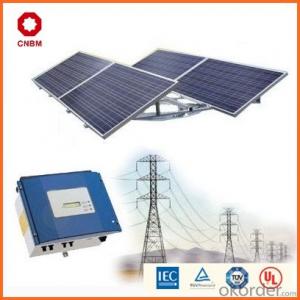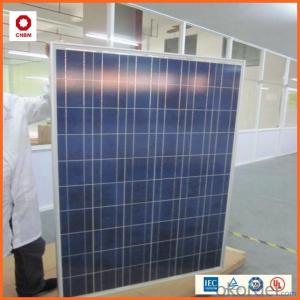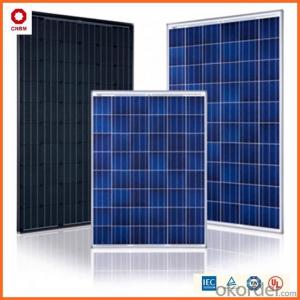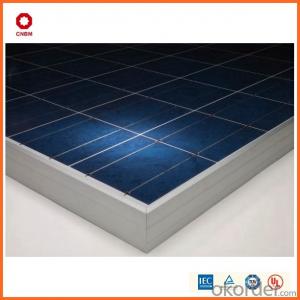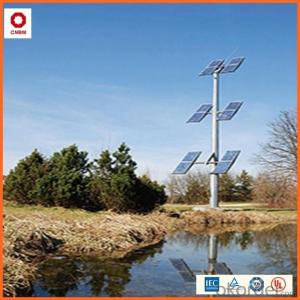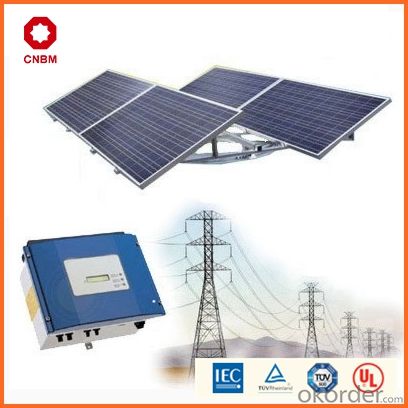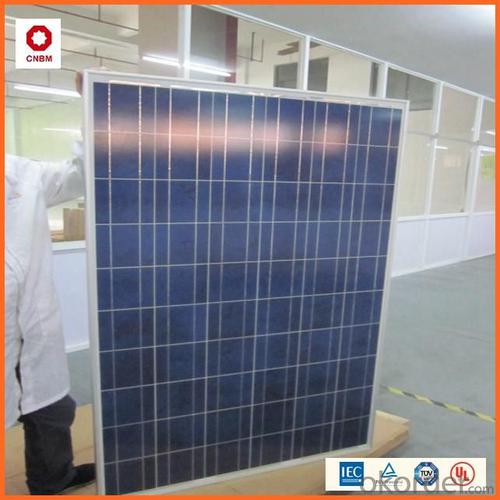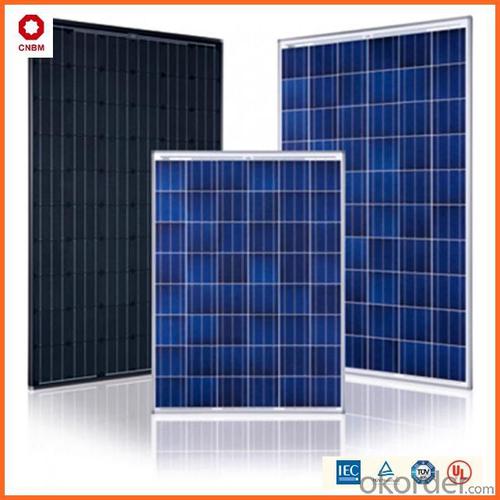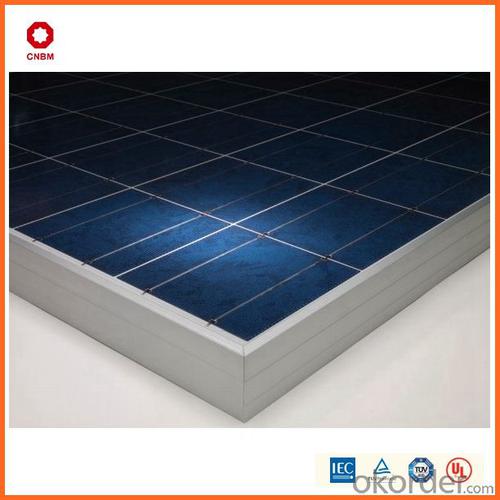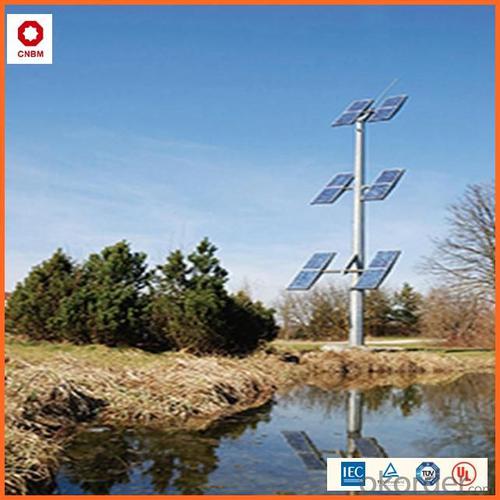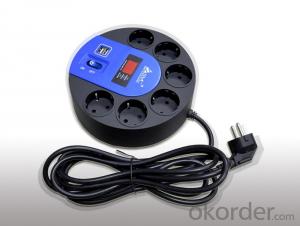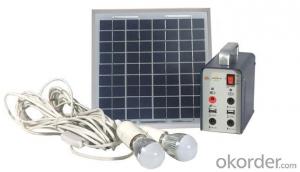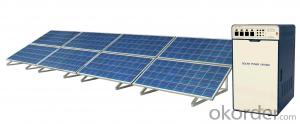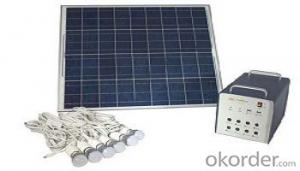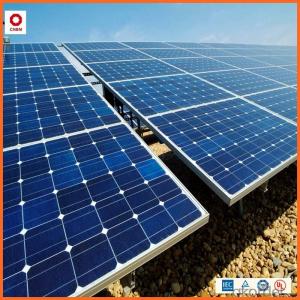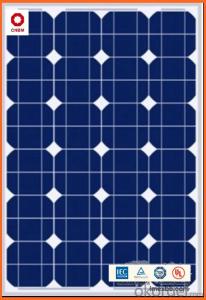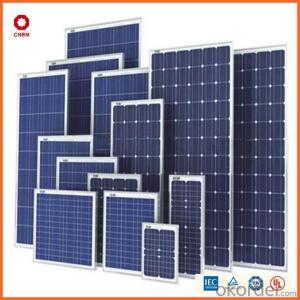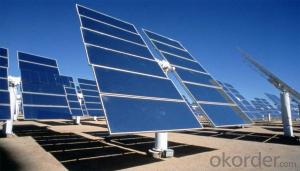Best Value 45w Small Solar Panels with Good Quality
- Loading Port:
- China main port
- Payment Terms:
- TT OR LC
- Min Order Qty:
- 1 watt
- Supply Capability:
- 10000000 watt/month
OKorder Service Pledge
OKorder Financial Service
You Might Also Like
Specification
Hot Sale !!! Quality and Safety of Small Poly Solar Panel 25~85w
1. Rigorous quality control meets the highest international standards.
2. High-transmissivity low-iron tempered glass, strong aluminium frame.
3. Using UV-resistant silicon.
4. IS09001/14001/CE/TUV/UL
Warranties of Small Poly Solar Panel 25~85w
1. 10 years limited product warranty
2. 15 years at 90% of the minimal rated power output
3. 25 years at 80% of the minimal rated power output
Specification
Characteristics of Poly solar panels CNBM (25-85W) | |||||
Max Power Voltage Vmp(V) | 30.3 | 30.8 | 31.1 | 31.4 | 31.85 |
Max Power Current Imp(A) | 7.60 | 7.64 | 7.73 | 7.81 | 7.85 |
Open Circuit Voltage Voc(V) | 36.1 | 36.6 | 37 | 37.3 | 37.68 |
Short Circuit Current Isc(A) | 8.50 | 8.55 | 8.65 | 8.75 | 8.85 |
Max Power Pm(W) | 230W | 235W | 240W | 245W | 250W |
Temperature Coefficient of Cells Poly solar panels CNBM (25-85W) | |
NOCT | 45± 2 |
Temperature Coeffucients of Isc | 0.0492 |
Temperature Coeffucients of Voc | -0.3374 |
Temperature Coeffucients of Voc | -0.4677 |
Mechanical Data of Poly solar panels CNBM (25-85W) | |
Dimension | 1638 × 982 × 40 mm |
Weight | 19.5 kg |
No. of Cells and Connections | 60 (6 ×10) |
Tolerance | 0 ~ + 5 W |
Cell | Monocrystalline Cell 156 × 156 mm |
Packing | 624 Pcs/40ft(H) Container |
Limits of Poly solar panels CNBM (25-85W) | |
Operating Temperature | -40 to +85 |
Storage Temperature | -40 to +85 |
Max System Voltage | 1000VDC(IEC) / 600VDC(UL) |
Features of our products:
• High conversion efficiency mono/poly-crystalline amorphous silicon solar cells
• Modules incorporate high performance bypass diodes to minimize the power drop caused by shading
• High transmittance, low-iron tempered glass
• High performance EVA encapsulant to prevent destroying and water.
• AI frame: without screw, corner connection. 8 holes on the frame can be installed easily
• Good performance of preventing from atrocious weather such as wind and hails
• Certifications: CE IEC TUV VDE UL, Class I
• 10 years 90% power output warranty
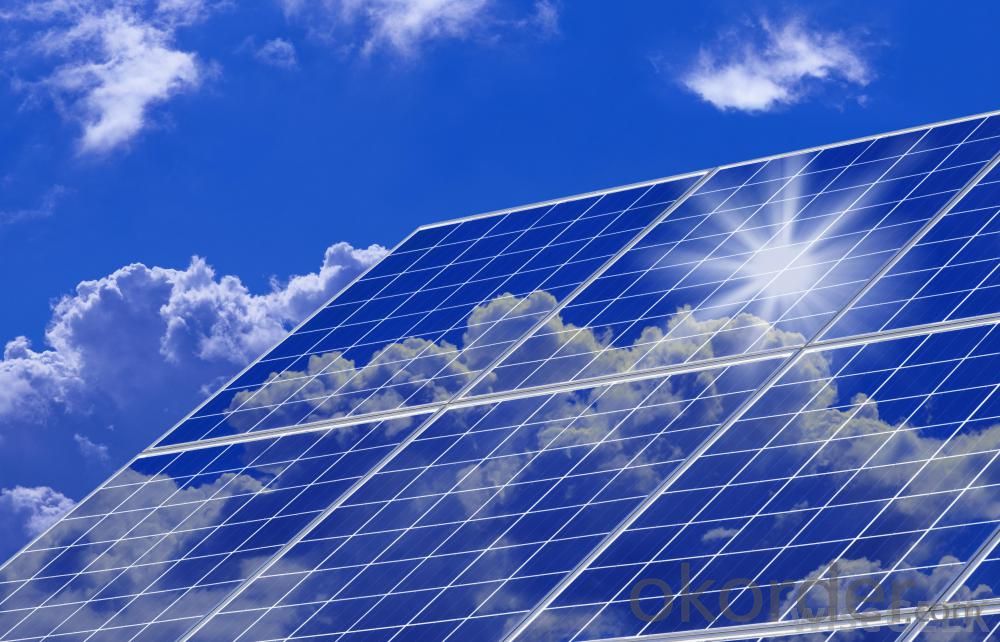
Shipping of Small Poly Solar Panel 25~85w
By Sea | Delivery from Shanghai or Ningbo seaport |
By Air | Departure from Shanghai Pudong Airport |
By Express | Post by DHL, EMS, UPS, TNT. |
- Q: Can solar energy systems be installed on the ground?
- Yes, solar energy systems can be installed on the ground. In fact, ground-mounted solar systems are a popular choice for both residential and commercial applications. These systems typically consist of solar panels mounted on a structure or framework that is anchored to the ground. Ground-mounted systems offer several advantages over rooftop installations, such as increased flexibility in system design, easier access for maintenance and cleaning, and the ability to optimize the orientation and tilt angle of the panels for maximum energy production. Additionally, ground-mounted systems can be installed in areas with limited roof space or where the roof is not suitable for solar panel installation. Overall, ground-mounted solar energy systems provide a practical and efficient way to harness the power of the sun for electricity generation.
- Q: Can solar energy systems be used in remote locations without access to the grid?
- Yes, solar energy systems can be used in remote locations without access to the grid. Solar panels can generate electricity from sunlight, which can then be stored in batteries for later use. This allows for off-grid power supply in remote areas, making solar energy a viable and sustainable option for providing electricity in such locations.
- Q: Are there any risks of electrical surges or voltage fluctuations with solar energy systems?
- Yes, there are potential risks of electrical surges or voltage fluctuations with solar energy systems. While solar panels themselves do not generate surges or fluctuations, the integration of solar energy systems with the existing electrical grid can create certain challenges. One risk is that sudden changes in sunlight intensity can result in voltage fluctuations. For example, when a cloud passes over a solar panel, the sudden decrease in sunlight can cause a drop in voltage output. Similarly, when the cloud passes, the sudden increase in sunlight can cause a surge in voltage output. These fluctuations can potentially affect the stability of the electrical grid. Another risk is related to the inverters used in solar energy systems. Inverters convert the direct current (DC) produced by solar panels into alternating current (AC), which is compatible with the electrical grid. Inverter failure or malfunction can lead to voltage fluctuations or surges, which can damage electrical equipment or disrupt the electrical supply. To mitigate these risks, solar energy systems are usually equipped with protective devices like surge protectors and voltage stabilizers. Surge protectors help prevent voltage spikes by diverting excess energy away from the system, while voltage stabilizers regulate voltage levels to ensure a steady and safe supply of electricity. Moreover, proper installation and regular maintenance of solar energy systems are crucial to minimize the risks of electrical surges or voltage fluctuations. Qualified professionals should handle the installation process, ensuring that all components are correctly connected and grounded. Routine inspections and maintenance checks can help identify and address any issues before they escalate into serious problems. Overall, while solar energy systems offer numerous benefits, it is important to be aware of and address the potential risks associated with electrical surges or voltage fluctuations. By implementing appropriate protective devices, following proper installation and maintenance procedures, and working with qualified professionals, these risks can be effectively managed, ensuring the safe and reliable operation of solar energy systems.
- Q: Are there any risks of electrical shocks during installation or maintenance of solar energy systems?
- During the installation or maintenance of solar energy systems, one must be aware of the risks of electrical shocks. These systems involve working with electrical components, such as solar panels, inverters, and batteries, which carry high voltage. Failure to follow proper safety measures can result in contact with live electrical parts and the possibility of receiving an electrical shock. Several factors can contribute to the risk of electrical shocks, including improper installation, insufficient knowledge or training in electrical systems, failure to use personal protective equipment (PPE), and inadequate grounding. It is crucial to adhere to safety guidelines and regulations when installing or maintaining solar energy systems. This includes wearing insulated gloves, using insulated tools, and ensuring proper grounding. Furthermore, working at heights during installation or maintenance introduces an additional hazard of electrical shocks. Care must be taken to prevent falls or accidental contact with live electrical parts while working on rooftops or elevated areas. To minimize the risks of electrical shocks, it is advisable to hire qualified and trained professionals for the installation and maintenance of solar energy systems. Regular inspections and maintenance checks should also be conducted to identify and address any potential electrical hazards. In conclusion, while solar energy systems offer many benefits, it is vital to be aware of the potential risks of electrical shocks and take the necessary precautions to ensure the safety of individuals involved in the installation or maintenance process.
- Q: Are there any government incentives for installing solar energy systems?
- Yes, there are government incentives for installing solar energy systems. Various countries offer incentives such as tax credits, grants, and rebates to encourage the adoption of solar energy. These incentives aim to lower the upfront costs of installation and make solar energy more affordable and accessible to homeowners and businesses. Additionally, some governments may provide feed-in tariffs or net-metering programs that allow solar system owners to earn credits or receive compensation for excess electricity generated.
- Q: Can solar energy systems be used for powering electric vehicle charging infrastructure?
- Yes, solar energy systems can definitely be used for powering electric vehicle (EV) charging infrastructure. Solar power is a clean and renewable energy source that can be harnessed through photovoltaic (PV) panels. These panels can be installed on rooftops, carports, or open fields, and they convert sunlight into electricity. The electricity generated by solar panels can be used to directly charge EVs or to power the EV charging infrastructure including charging stations, grid-tied DC fast chargers, or battery storage systems. By using solar power to charge electric vehicles, we can significantly reduce greenhouse gas emissions and dependency on fossil fuels. Solar-powered EV charging infrastructure offers numerous benefits. Firstly, it helps reduce the carbon footprint associated with transportation by using clean energy instead of relying on electricity from the grid, which is often generated from fossil fuel sources. Secondly, it provides an opportunity for decentralized energy production, allowing EV owners to charge their vehicles with renewable energy generated on-site. This reduces strain on the electric grid and promotes energy independence. Furthermore, solar EV charging infrastructure can be combined with energy storage systems such as batteries. This enables the storage of excess solar energy during the day and its utilization for EV charging during the night or when the sun is not shining. Battery storage can also help manage peak demand and ensure a more stable and reliable power supply for the charging infrastructure. The implementation of solar-powered EV charging infrastructure is a growing trend globally. Public and private entities are installing solar panels at charging stations, parking lots, and highways to provide sustainable and economical charging options for electric vehicle owners. Additionally, government incentives and subsidies are often available to encourage the adoption of solar energy and EVs. In conclusion, solar energy systems can be effectively used for powering electric vehicle charging infrastructure. This combination provides a sustainable and clean solution for transportation, reduces carbon emissions, and promotes energy independence.
- Q: Can solar energy systems be used in areas with limited access to solar energy insurance coverage?
- Yes, solar energy systems can still be used in areas with limited access to solar energy insurance coverage. While insurance coverage is important for protecting the investment in solar energy systems, its availability may vary in certain regions. However, with proper maintenance, monitoring, and risk management strategies, solar energy systems can still provide sustainable and cost-effective electricity generation in these areas.
- Q: Can I install solar panels myself?
- Yes, it is possible to install solar panels yourself, but it is recommended to hire a professional installer for safety and to ensure proper installation and system performance.
- Q: Can solar energy systems be used in powering sports stadiums?
- Yes, solar energy systems can definitely be used to power sports stadiums. In fact, many stadiums around the world have already started implementing solar energy systems to meet their energy needs. Solar panels can be installed on the rooftops, parking lots, or open spaces surrounding the stadium to capture sunlight and convert it into electricity. The main advantage of using solar energy in powering sports stadiums is its sustainability and cost-effectiveness. Solar energy is a renewable source of energy that does not emit any greenhouse gases during its operation, making it environmentally friendly and helping to reduce carbon footprint. Moreover, once the initial investment is made in installing the solar panels, the ongoing operational costs are relatively low, which can result in significant savings on the stadium's energy bills. The size and structure of sports stadiums make them ideal candidates for solar energy systems. The large surface areas of stadiums provide ample space for installing a significant number of solar panels, which can generate a substantial amount of electricity. Additionally, the open spaces surrounding the stadium allow for optimal sunlight exposure, ensuring maximum energy generation. Furthermore, solar energy systems can be integrated with other technologies to enhance their efficiency and functionality. For instance, battery storage systems can be employed to store excess energy generated during the day and use it during night events or during periods of low sunlight. This ensures a continuous and reliable power supply to the stadium, regardless of the weather conditions or time of day. In conclusion, solar energy systems can definitely be used in powering sports stadiums. They offer a sustainable and cost-effective solution to meet the energy needs of these large facilities, while also reducing their environmental impact. With further advancements in solar technology and decreasing costs, it is expected that more sports stadiums worldwide will embrace solar energy as a primary source of power in the future.
- Q: What is the role of solar energy systems in reducing dependence on fossil fuels?
- Solar energy systems play a crucial role in reducing dependence on fossil fuels by providing a clean and renewable source of energy. Fossil fuels, such as coal, oil, and natural gas, have been the primary sources of energy for centuries. However, their extraction, transportation, and combustion have significant environmental impacts, including air pollution, greenhouse gas emissions, and climate change. Solar energy systems, on the other hand, utilize the power of the sun to generate electricity. Solar panels, made up of photovoltaic cells, convert sunlight into usable energy without emitting any harmful pollutants. This clean energy source not only helps to mitigate climate change but also improves air quality and reduces health risks associated with fossil fuel combustion. By embracing solar energy systems, we can reduce our dependence on fossil fuels for electricity generation, heating, and cooling. Solar power is abundant, widely distributed, and available throughout the year, making it a reliable and sustainable energy option. Moreover, solar energy systems can be installed on various scales, from residential rooftops to large-scale solar farms, allowing individuals, communities, and businesses to contribute to the transition away from fossil fuels. Not only does solar energy reduce our carbon footprint, but it also provides economic benefits. As the technology advances and becomes more widespread, the cost of solar panels and installation continues to decline. This makes solar energy more affordable and accessible for both individuals and businesses, leading to job creation and economic growth in the renewable energy sector. Furthermore, solar energy systems offer energy independence and resilience. Unlike fossil fuels, which are finite resources and subject to price volatility, sunlight is abundant and freely available. By harnessing solar power, we can reduce our reliance on imported fossil fuels, enhance energy security, and create a more stable and sustainable energy supply. In conclusion, solar energy systems play a crucial role in reducing dependence on fossil fuels. By harnessing the power of the sun, we can transition to a cleaner, more sustainable, and resilient energy future. Solar energy helps mitigate climate change, improve air quality, create jobs, and provide energy independence. It is a viable solution that enables us to reduce our environmental footprint while meeting our energy needs.
Send your message to us
Best Value 45w Small Solar Panels with Good Quality
- Loading Port:
- China main port
- Payment Terms:
- TT OR LC
- Min Order Qty:
- 1 watt
- Supply Capability:
- 10000000 watt/month
OKorder Service Pledge
OKorder Financial Service
Similar products
Hot products
Hot Searches
Related keywords
